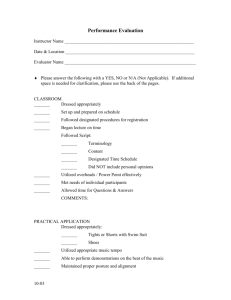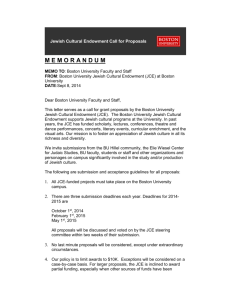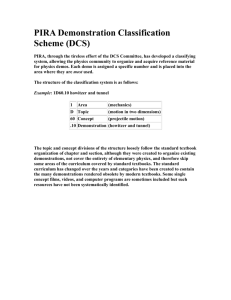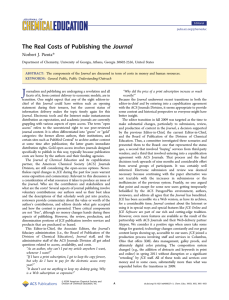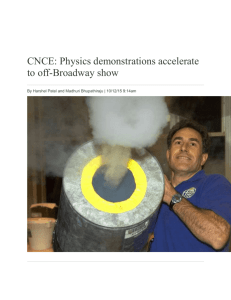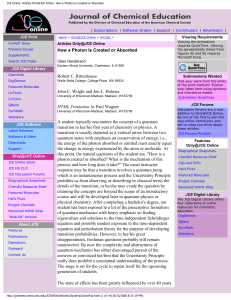P401: The history of Tested Demonstrations and future of
advertisement
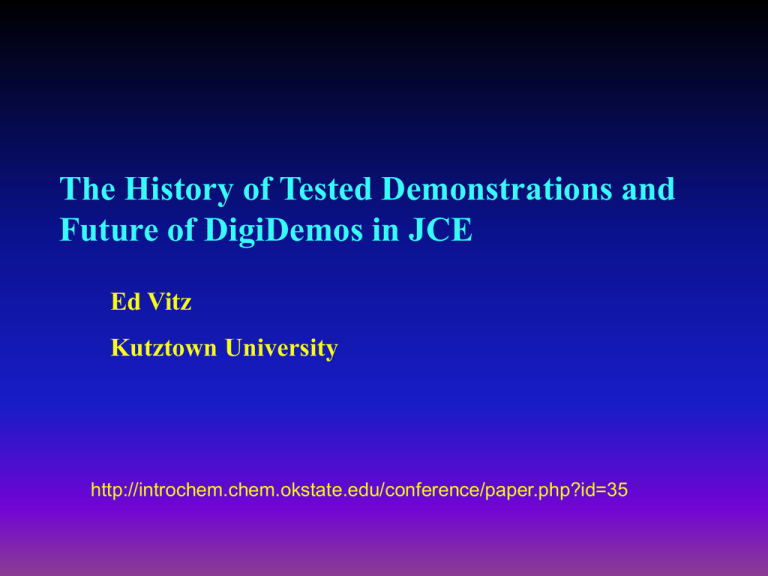
The History of Tested Demonstrations and Future of DigiDemos in JCE Ed Vitz Kutztown University http://introchem.chem.okstate.edu/conference/paper.php?id=35 “Ancient History” of Chemical Demonstrations Paracelsus (1493-1541) Karl Heumann in Germany (1876) earliest separate demonstration book Heumann’s text includes blank pages after each demonstration so that lecturers can enter notes describing improvements or alterations. This feature proved valuable, and DigiDemos has adopted and improved on it: Users’ notes will be online and accessible to all, not just readers of a particular book. For example, see Dave Tanis’ addendum to A-5 Electrolysis of Water at: http://forums.divched.org:8000/webx?14@51.tqt2aIq2bLU.2@.1ad4b3bd/2 1. Jensen, William B. “To Demonstrate te Truths of ‘Chymistry’”, Bull. Hist. Chem. 10, (1991), pp. 3-15. 2. Kauffman, G.B., The Chemical Educator, Vol 1 (5) 1430-4171. Michael Faraday (1791-1867) Michael Faraday: City Philosophical Society Presentations 1810 and his Course of Six Elementary Lectures on Chemistry Adapted to a Juvenile Audience presented at The Royal Institution of Great Britain during the Christmas Season of 1827. We’ll add video and still photos to DigiDemos to emulate the flair of Michael Faraday’s Presentations. Smith, P.E. “On the Place of ‘Noise and Splendor’ in Faraday’s Chemical Demonstrations”, ChemEd 95, Old Dominion Univ., Norfolk, VA New Demos: Nanotubes As the first photographer interested in nanotechnology discovered… A photographic strobe will ignite carbon nanotubes! Single walled carbon nanotubes have high black body emissivity (absorbance), and energy can only be dispersed over a short distance in two dimensions. http://www.sciencemag.org/cgi/content/full/296/5568/705/DC1 Campbell, D.J., McCann, J.T., and Xia, Y. “Classroom Scale Demonstrations Using Flash Ignition of Carbon Nanotubes” J. Chem. Educ. In Press (at BCCE!) The Journal of Chemical Education has been published since 1924. The first issues of JCE were each ~20 pages. This is the introductory issue in January 1924 with editorial comment by N.E.G., who was…? Neil Gordon Benfey, T. J. Chem. Educ. 2003, 80, 651-7 Bohning, James J. J. Chem. Educ. 2003, 80, 642–650; First JCE Demo The earliest published demonstration in the Journal of Chemical Education (JCE) appeared in volume 1 (1924), “A New Lecture Table Outfit for Demonstration Conductivity to Elementary Classes” [*Cavison, H.F. JCE 1 (4), 74 (1924)] We have learned that retroactive addition of safety information in DigiDemos can be a valuable asset. For example, see Jim Maynard’s Safety note linked to the Thermite Reaction at http://forums.jce.divched.org:8000/webx?14@101.tqtkaMFjb4Q.15@.1ada928f The Art of the Lecture Demonstration JCE, June, 1925 Notes on Pedagogy can be added to demonstrations where this is lacking. The Usefulness of the Lecture Demonstration Even the Journal of the American Chemical Society occasionally published a lecture demonstration, but that was not the mission of the Journal… Browne, A.W. and R. S. von Hazmburg, J. Am. Chem. Soc. 48, 2383-5 (Sept., 1926). (SCSN3)2 explodes with mechanical shock, heat or stream of NH3 (g) DigiDemos categories for demos that should not be repeated, or which require special expertise Many Demonstrations appeared in in the first 25 years They were scattered and in different formats, with occasional short series.. DigiDemos collects them in one organized, easily searchable location Pedagogy of the Lecture Demonstration Symposium on Lecture Demonstration Method vs. Individual Laboratory Work, 89th ACS Meeting, NY, 1935 JCE, February 1936 Technique of the Lecture Demonstration (1948) JCE reported extensively on Symposia on Novel Lecture Demonstrations at the National ACS meetings in 1947 (1) and 1948 (2), with contributions of a score or more authors. 1. Alyea, H.N. et al, JCE 25, 249-261 (1947) 2. Daugherty, T.H. et al, JCE 26, 482499(1948). Bibliographies of Lecture Demonstrations (1950) Derrick, J. O. One hundred high-school chemistry projects, J. Chem. Educ. 1940, 17, 492. Derrick, J. O. A Bibliography of Chemistry Projects and Demonstrations, J. Chem. Educ. 1950, 17, 562-564. [158 references to books, magazine and journal articles.] February 1955: Tested Demonstrations Collections of demonstrations established a genre, but lacked uniformity and completeness that DigiDemos can provide First Tested Demonstrations (1955) “DETACH SHEET BY CUTTING ALONG THIS LINE—PUNCH HOLES AND REINFORCE WITH GUMMED LINEN REINFORCEMENTS” The first “Sheets”, Numbers 1-24, were in “A” series pages, compiled by Hubert Alyea; subsequent Sheets by Frederic Dutton. Tested Demonstrations continued in the new, expanded format in 1961. Tested Demonstrations Collections Hubet Alyea and Fred Dutton, Tested demonstrations in chemistry, Journal of Chemical Education, 6th ed. Easton, Pa. 18042 (1965). Gilbert, G.L. Alyea, H.N., Dutton, F.B. and Dreisbach, D. (Eds.), "Tested Demonstrations in Chemistry" (2 volumes), Journal of Chemical Education and Division of Chemical Education, Inc., American Chemical Society, Easton, 1994. What’s Next? What are Digi-Demos? JCE Portal What are Digi-Demos? http://jchemed.chem.wisc.edu/JCEDLib/DigiDemos/index.html What are Digi-Demos? http://forums.jce.divched.org:8000/JCE/DigiDemos/ What are Digi-Demos? http://forums.jce.divched.org:8000/JCE/DigiDemos/Demos/?14@63.jtdvajs9bk7.0@ What are Digi-Demos? What are Digi-Demos? Table of Contents: Post a Message Table of Contents: Post a Message Back to Menu: Table of Contents Table of Contents Table of Contents: 25 “Standard” Chapters Table of Contents: 4. Chemical Equations Table of Contents: A-15 Fundamental Laws Didn’t Want Fundamental Stochiometry? Search From Anywhere in DigiDemos Search Results: Limiting Reagent Strengths of DigiDemos 1. Tested: JCE TDs are the Foundation of DigiDemos. We are responsible for Tested demonstrations! 2. Timeless: the JCEDL is a publisher as well as a purveyor of information: a new concept of a library. We are not just a digital library of links. The prestige lent by peer review is a strong incentive to authorship. DigiDemos become part of the body of scholarly literature that is accessed in the same manner as Kekule’s papers in Justus Leibig's Annalen der Chemie (1875-1978) or Berichte de Deutschen Chemische Gesellschaft (1868-1905)! Strengths of JCE DigiDemos 3. Tied to other JCE Resources: CLIPs, CCA videos, related demonstrations, color figures, sound, etc. 4. Teacher Participation: Pedagogy, technique, safety continually updated. 5. Documentation: Metadata standards include bibliographic data to make DigiDemos traceable. [http://metadata.net/] 6. Searchable DigiDemos to Come: “Simultaneous Display of Spectral Images and Graphs Using a Web Camera and Fiber Optic Spectrometer”* These Supplemental Materials are designed to help students correlate the appearance of a source to its spectroscopic and spectrographic representations: *Niece, B.K. J. Chem. Educ. In Press Simultaneous Display of Spectra In addition to color, DigiDemos allow interactivity: Online PDF Niece, Brian K. J. Chem. Educ. 2006 83 761. New Demos (with Permission): Narra According to Harvey, the first recorded observation of fluorescence dates to the year 1574. The writings of the Spanish physician and botanist Nicolas Monardes describe a wood from New Spain called Lignum nephriticum, which was used as a medical treatment for liver and kidney aliments. Fluorescence was noticed in water contained in narra wood cups. Muyskens, M. A. “The Fluorescence of Lignum nephriticum: A Flash Back to the Past, and a Simple Demonstration of Natural Substance Fluorescence” J. Chem. Educ. In Press Acknowledgements We gratefully acknowledge National Science Foundation support under NSDL grant # 0226244, “The Journal of Chemical Education Digital Library.” End
